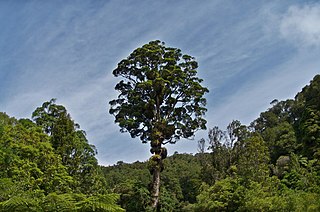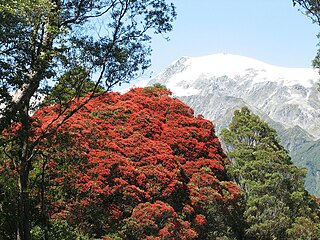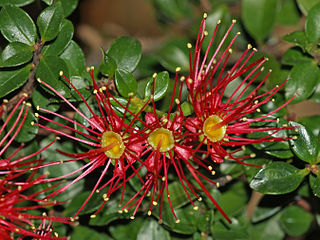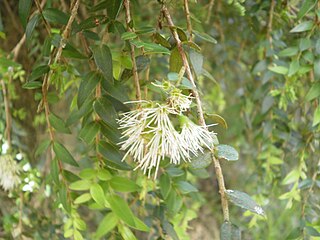
Metrosideros excelsa, with common names pohutukawa, New Zealand Christmas tree, New Zealand Christmas bush, and iron tree, is a coastal evergreen tree in the myrtle family, Myrtaceae, that produces a brilliant display of red flowers made up of a mass of stamens. The pohutukawa is one of twelve Metrosideros species endemic to New Zealand. Renowned for its vibrant colour and its ability to survive even perched on rocky, precarious cliffs, it has found an important place in New Zealand culture for its strength and beauty, and is regarded as a chiefly tree by Māori. The blossom of the tree is called kahika.

The weka is a flightless bird species of the rail family. It is endemic to New Zealand. Four subspecies are recognized but only two (northern/southern) are supported by genetic evidence. Weka are sturdy brown birds, about the size of a chicken. As omnivores, they feed mainly on invertebrates and fruit. Weka usually lay eggs between August and January; both sexes help to incubate.

The forest ringlet, also known as Helms' butterfly, is a rare butterfly of the family Nymphalidae endemic to New Zealand. It is the only species in the genus Dodonidia.

Argosarchus is a monotypic genus in the family Phasmatidae containing the single species Argosarchus horridus, or the New Zealand bristly stick insect, a stick insect endemic to New Zealand. The name "horridus" means bristly in Latin, likely referring to its spiny thorax.

Metrosideros bartlettii, also known as Bartlett's rātā, Cape Reinga white rātā or in Māori as rātā moehau, is one of twelve Metrosideros species endemic to New Zealand and is notable for its extreme rarity and its white flowers, somewhat uncommon in that genus of red-flowered trees and plants. Its natural range is in the far north of the North Island at Te Paki, in three patches of dense native forest near Spirits Bay that escaped destruction by fire, namely Radar Bush, Kohuronaki Bush, and Unuwhao Bush. Only 13 adult trees are known to exist in the wild and most of these are either ill or dying. The lack of fossil evidence elsewhere suggests that the tree may always have been restricted to the North Cape area, which was an island until it was connected to the mainland by the sandspit that constitutes Ninety Mile Beach.

Metrosideros robusta, the northern rātā, is a forest tree endemic to New Zealand. It grows up to 25 metres (82 ft) or taller, and usually begins its life as a hemiepiphyte high in the branches of a mature forest tree; over centuries the young tree sends descending and girdling roots down and around the trunk of its host, eventually forming a massive, frequently hollow pseudotrunk composed of fused roots. In disturbed ground, or where there are gaps in the forest cover, Northern rātā will grow on the ground with a normal but short trunk.

Metrosideros umbellata, the southern rata, is a tree endemic to New Zealand. It grows up to 15 metres (49 ft) or more tall with a trunk up to 1 metre or more in diameter. It produces masses of red flowers in summer. Unlike its relative, northern rata, this species rarely grows as an epiphyte.

Metrosideros fulgens is a forest liana or vine endemic to New Zealand. It occurs in coastal and lowland forest throughout the North Island, on the west coast of the South Island and on the Three Kings Islands north of Cape Reinga. It is one of a number of New Zealand Metrosideros species which live out their lives as vines, unlike the northern rata (M.robusta), which generally begins as a hemi-epiphyte and grows into a huge tree. Scarlet rātā is one of the better-known species of rātā vines, because it flowers in autumn or winter, and is often highly visible on well-lit host trees along forest roads, with vibrant displays of large red flowers that rise above the forest canopy.

Metrosideros carminea is a forest liane or vine that is endemic to New Zealand. It occurs in coastal and lowland forest from Te Paki in the north of the North Island south to Mahia Peninsula and Taranaki. It is one of a number of New Zealand Metrosideros species which live out their lives as vines, unlike the northern rata (M.robusta), which generally begins as a hemi-epiphyte and grows into a huge tree.
Ctenarchis is a genus of moths of the Carposinidae family, containing only one species, Ctenarchis cramboides. This species is endemic to New Zealand. It is classified as "At Risk, Naturally Uncommon" by the Department of Conservation.

Project Crimson is a conservation initiative to promote the protection of the pōhutukawa and the rātā which are under threat due to browsing by the introduced common brushtail possum. The vision of the project is to "enable pōhutukawa and rātā to flourish again in their natural habitat as icons in the hearts and minds of all New Zealanders."

Clitarchus hookeri, is a stick insect of the family Phasmatidae, endemic to New Zealand. It is possibly New Zealand's most common stick insect. Clitarchus hookeri is often green in appearance, but can also be brown or red. Alongside the prickly stick insect and the Unarmed stick insect, C. hookeri is one of three stick insect species to have become naturalised in Great Britain, with all three having originated in New Zealand.

Metrosideros colensoi, the climbing rata or Colenso's rātā, is a forest liane or vine that is endemic to New Zealand. It is one of a number of New Zealand Metrosideros species which live out their lives as vines, unlike the northern rata (M.robusta), which generally begins as a hemi-epiphyte before growing into a huge tree. It grows to around 6 metres in height and bears clusters of pink or white flowers. It is unusual amongst New Zealand's metrosideros species in that its branches display a weeping habit, forming a 'hanging curtain' appearance. This behaviour is uncommon in New Zealand native plants. The name commemorates William Colenso, an early Cornish Christian missionary who was one of the great characters of New Zealand botany.
Metrosideros parkinsonii, also known as Parkinson's rātā or shrubby rata, is a shrub or small tree endemic to New Zealand. The name commemorates Sydney Parkinson, Captain James Cook's botanical artist during his first voyage to New Zealand.

Metrosideros albiflora, also known as large white rātā, Northland white rātā, akatea or simply white rātā, is a forest liane or vine endemic to New Zealand. It is one of three white flowering rātā vines. The name "albiflora" indeed literally means white flowered. Despite the similar names, large white rātā is distinguished by its much larger leaves and flowers. Its flowers are amongst the largest of any rātā, similar in size to both scarlet rātā and pōhutukawa. It occurs almost exclusively in Kauri forests from the northern Kaimai Ranges to Te Paki at the top of the North Island.
Clitarchus rakauwhakanekeneke is a stick insect that belongs the common New Zealand genus Clitarchus. It lives only on the Poor Knights Islands.
Clitarchus tepaki is a stick insect that belongs to the common New Zealand genus Clitarchus. It is endemic to the North Cape area of New Zealand, in particular Te Paki and the Karikari Peninsula.
Gymnobathra rufopunctella is a species of moth in the family Oecophoridae. This species is in need of taxonomic revision and probably belongs to a separate genus. It is endemic to New Zealand. It has been classified as Data Deficient by the Department of Conservation.

Spinotectarchus acornutus is a species of stick insect endemic to New Zealand. It belongs to the family Diapheromeridae, and is the only member of the genus Spinotectarchus. It is commonly referred to as the spiny ridge-backed stick insect.

John Kenneth Bartlett was a New Zealand plant collector and botanist who specialised in mosses, liverworts, and lichens. In 1974, he found Bartlett's rātā growing south-east of Cape Reinga.















